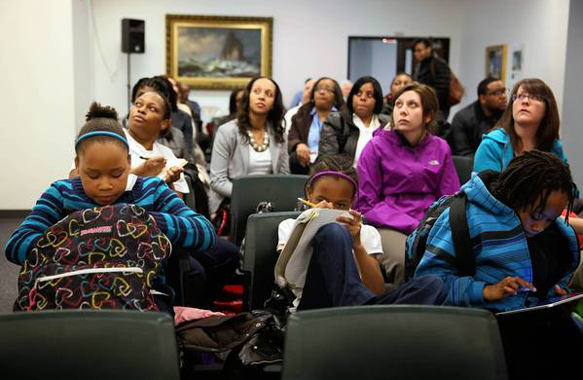Students do their homework during a public hearing in April on the proposal to close Dumas Technology Academy and consolidate the school with Wadsworth Elementary. The hearing was held at Chicago Public Schools headquarters. (E. Jason Wambsgans, Chicago Tribune / April 25, 2013)
By Eve Rips | Originally Published at Chicago Tribune. October 16, 2013
The ideal of schools as democratic communities has deteriorated in Chicago, leaving many residents feeling voiceless and disengaged.
“Democracy needs to be reborn in each generation, and education is its midwife.”
~ John Dewey
Students and parents across Chicago have thoughtful concerns about their schools but often feel that they have no way to effect change within the Chicago Public Schools system.
Twentieth-century education reformer John Dewey thought that schools should be institutions “in which the child is, for the time, to be a member of a community life in which he feels that he participates, and to which he contributes.” Today in Chicago we have an unelected school board that meets at a time when students and working parents are typically unable to attend. Students remain uncertain about their ability to critique and protest school policies. Comments made by parents and students at official hearings on recent school closings went almost entirely ignored. The ideal of schools as democratic communities has deteriorated in Chicago, leaving many residents feeling voiceless and disengaged.
Chicago needs to bring back the vision of the public school as a democratic community. With many Chicagoans feeling detached from the city, and voting rates consistently low in local elections, we need to reinvigorate civic involvement, starting with involvement in the schools. In the Daniel Burnham spirit of making no little plans, the Educational Equity Project of the Chicago Lawyers’ Committee for Civil Rights Under Law presents five ways in which democratic engagement could be fostered by CPS.
1. An elected school board
Chicago is the only school district in Illinois where the school board is appointed by the mayor rather than democratically elected. A 2012 poll by WGN and the Chicago Tribune found that 77 percent of Chicagoans are in favor of an elected school board. The effects of this were felt when the board voted swiftly and unanimously in favor of mass school closings. The movement for an elected school board is growing quickly. In August, hundreds of students marched at City Hall demanding a representative board, and the Chicago Teachers Union and grass-root groups have been mobilizing around the issue. The message is clear: School board members should to be held directly accountable to voters.
2. School board meetings in the evening
Although the CPS website declares that “(m)embers of the public are welcome to voice their comments during the public participation portion of the meeting,” board meetings are consistently held on weekdays during school and work hours. Shifting the meetings to a later time would enable more participation from the true stakeholders.
3. Stronger bill of rights for students and families
CPS took the admirable step this year of adding the right “(t)o express opinions, support causes, assemble to discuss issues, and engage in peaceful and responsible demonstrations” to the Student Code of Conduct. While this is a fantastic first step, more is needed. In New York City, public school students have a three-page bill of rights that specifies that free expression includes the right to publish critical newspaper articles, wear political buttons, and distribute leaflets and independent newspapers. New York’s code also grants students the right to “representation on appropriate schoolwide committees that influence the educational process, with voting rights where applicable.” These rights empower students, and help create lifelong political engagement.
4. Responding respectfully to student dissent
This past April, hundreds of students from Voices of Youth in Chicago Education staged a peaceful boycott during the Prairie State Achievement Exam. Before the protests took place, many students were warned that participation would mean suspension. Some were also informed that they would be banned from the makeup testing session. Although all students were eventually permitted to take the makeup, these threats deterred some students from participating in the protests and illustrate why many students find it hard to express strong views about school policies. We should be taking student concerns seriously, rather than threatening punishment.
5. Democratic discipline
In 2007, CPS incorporated restorative practices into the Student Code of Conduct. These alternative measures of dealing with student misconduct include peer juries and peace circles, both of which encourage discussion between a referred student and other members of the school community. These restorative tools are empowering and provide students with an active role in shaping the way their school responds to problematic behavior. At the Chicago Lawyers’ Committee for Civil Rights Under Law, we commend CPS for including restorative discipline in the Student Code of Conduct and encourage the use of these techniques more frequently.
These five measures are not the only ways to re-imagine CPS as a more democratic community. A more democratic CPS might mean increased student leadership and decision-making within student groups; a larger role for the Local School Councils; or increased transparency and accountability with respect to school data. It might also mean an increase in civic education within the schools to prepare students for democratic engagement outside of the CPS community.
Education reformer Theodore “Ted” Sizer stated that “the best way to teach values is when the school is a living example of the values to be taught.”
In our plan for a new Chicago, CPS would serve as a living example of democratic engagement.
Eve Rips is a civil rights fellow with Chicago Lawyers’ Committee for Civil Rights Under Law.
Copyright © 2014 Chicago Tribune Company, LLC












Leave A Comment